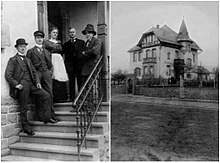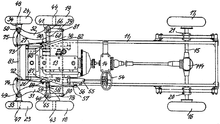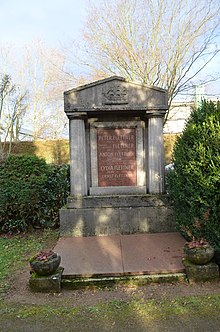Anton Flettner
Anton Flettner (born November 1, 1885 in Eddersheim near Frankfurt am Main , † December 25, 1961 in New York City , USA ) was a German teacher, engineer and inventor .
First work and shipbuilding
At the age of 29, he presented his first invention, a steerable torpedo , to the then Reichsmarineamt . This, like his next invention in 1915, a remote-controlled combat vehicle, was rejected because it was not considered technically feasible.
After the First World War, Flettner started thinking about how to reduce the labor-intensive and time-consuming work involved in propelling sailing ships . Metal sails equipped with an auxiliary rudder should replace the usual cloth sails. Before a conversion of a ship with metal sails, which had already been planned in Kiel, was carried out, he heard about the experiments with rotating cylinders at the aerodynamic research institute in Göttingen. With the help of the test results, he developed the so-called Flettner rotor , which exploited the Magnus effect : a rotating cylinder exposed to the wind flow generated a force across the flow from the suction and the dynamic pressure forces. In the case of the Flettner rotor as a ship drive in so-called rotor ships , high cylinders made of sheet metal on deck rotate at a variable speed.

This rotor was tested on two ships, 1924–1926 on the Buckau (later renamed Baden-Baden ) and 1926–1932 on the Barbara , but was not widely used. The principle of the rotor is, partially modified, today on the ships Alcyone by Jacques-Yves Cousteau , the Uni-Kat Flensburg baptized in 2006 and the rotor cargo ship E-Ship 1 , which was launched on August 2, 2008 at the Lindenau shipyard in Kiel ran, applied.
Around 1925 Flettner experimented with a "three-wing rudder" on ships (see under literature).
Aviation Developments
In 1927 Flettner turned to aviation. He constructed an aircraft rudder with an auxiliary control surface. He later developed this invention, known as the Flettner rudder or Flettner flap, for use in shipbuilding.
The construction of a rotary wing aircraft that he had planned was only successful after many setbacks after about eight years around 1935 with the Fl 184 and Fl 185 . In 1938 Flettner designed the Fl 265 together with Kurt Hohenemser . This new type of helicopter solved the problem of torque compensation by means of rotors intermeshing in opposite directions ( Flettner double rotor ). In 1940 he developed the Flettner Fl 282 Kolibri , which was built similar to the previous model; two of these helicopters ended up in the USA as spoils of war. There they were thoroughly tested and influenced the helicopter development of the Kaman Aircraft Corporation , which subsequently developed its own constructions based on the Flettner double rotor principle. During the Second World War , the Kellett Aircraft Corporation built a helicopter based on the Flettner principle, the XR-8 .
After the end of the war, Flettner initially stayed in Bad Tölz and continued to work with his helicopter system. In 1947 he went to the United States, where he became an advisor to the Office of Naval Research (ONR) and soon after became an American citizen. He founded Flettner Aircraft Corporation in Kew Gardens, Queens , New York City in 1949 . He won Charles E. Rosendahl as vice president, and Eugene Liberatore became assistant to the technical management, while Flettner himself acted as president and took over the overall technical management. His company was mainly active as a consultant to the US Navy on innovative aircraft concepts and in the further development of the Flettner double rotor. Flettner briefly considered entering into a connection with Kaman, but then decided against this project because he was dealing with the jet propulsion of crane helicopters at the time.
Further developments
Among other things, Anton Flettner is also responsible for the well-known Flettner fans , which enable air to be exchanged in closed rooms without their own drive. This development may have been influenced by the Savonius rotor , which was invented in 1924 by the Finn Sigurd Savonius and whose German patent Flettner bought up. The continuously rotating fans were widespread in delivery vans, buses, railroad cars and boats from the 1930s to 1960s. The company Flettner Ventilator Limited in Milton Keynes, UK, is still Flettner ventilator ago.

Anton Flettner designed the five-axle " Krupp-Flettner-Großkraftwagen " in 1930 . This consisted of a single-axle Krupp motor vehicle and a coupled four-axle vehicle with the usable area. The two rear axles were driven by a drive shaft leading from the motor vehicle with three cardan joints . The first two axles of the utility vehicle (axis 2 and 3) were automatically controlled by the linkage of the normally steered motor vehicle. This should protect the driver's strength and increase operational safety. A prototype was produced until 1931 and presented at the Berlin Motor Show. The 13.74 m long vehicle was then used by KVG Sachsen , at that time the largest bus operator in Germany, to transport LPG bottles. The construction of a five- axle large bus , which was planned until the mid-1930s , was no longer realized.
Anton Flettner applied for more than 1,000 patents from 1912 to 1960. He is buried in the Eddersheim cemetery. His tomb is a listed building. In his listed birthplace, the Flettner Villa , the municipal kindergarten "Villa Kunterbunt" of Eddersheim is housed today .
Honors
In some German cities such as Cuxhaven , Raunheim , Hattersheim am Main and Werder (Havel) there are Anton-Flettner-Straße.
literature
- Ahnhudt: The Flettner oar. In: Marine-Rundschau. Journal of marine life. Mönch, Bonn 1924, ISSN 0025-3294 , pp. 18-29.
- Emo Descovich: Flettner's oars, sails and rotor: a popular attempt at explanation. Austrian Federal Publishing House for Education, Science and Art, Vienna 1925.
- Josef Esser: The Flettner ship. G. D. Baedeker, Essen 1925.
- Anton Flettner: My way to the rotor. Köhler & Amelang, Leipzig 1926.
- Uwe Greve: Buckau and Barbara. The experiment of the rotor ships. DBM-Media, Berlin 1995 (= Ships-People-Fates, No. 20, Volume 3).
- Frank Grotelüschen: Torque: Anton Flettner succeeds in 1924, what all sailors dream of: his rotor ship sails against the wind. In: Mare - the magazine of the seas. (2004), 45, pp. 38-41. Dreiviertel-Verlag, Hamburg, ISSN 1432-928X .
- W. Heberling: The screw-in motor ship “Therese Horn” and its test drives with the Flettner three-wing rudder. In: shipyard, shipping company, port. Organ of the shipbuilding society, the port building society, the merchant ship standards committee and the archives for shipbuilding and shipping e. V. Volume 6 (1925), 1st Springer, Berlin 1925, ISSN 0372-7491 .
- Hans-Jürgen Reuß: Flettner rotor ships - old technology for new ships. In: HANSA International Maritime Journal. (2007), 12, pp. 16-22. Schiffahrts-Verlag “Hansa” C. Schroedter & Co., Hamburg 2007.
Web links
- Sabine Hock : Flettner, Anton in the Frankfurter Personenlexikon
- Biography (helicoptermuseum.de)
- Frank Grotelüschen: "Torque" (www.mare.de)
Individual evidence
- ^ Anton Flettner: Airplane with rotating wings. Swiss patent 172251, class 129 b, application filed on July 29, 1933, patent registered on September 30, 1934. In: Patentschrift. Federal Office for Intellectual Property, published on January 2, 1935. In: German Patent and Trademark Office, (PDF ; 74 kB), accessed on December 30, 2018.
- ↑ David A. Anderton: German Rotorcraft Pioneer Comes Back . In: Aviation Week November 29, 1954, p. 28
- ^ E. Hirschel, H. Prem, G. Madelung: Aviation Research in Germany - Die deutsche Luftfahrt Vol. 30 , 2001, p. 286
- ↑ Sigurd Savonius: Device driven by air flow for ventilation of enclosed spaces or for improvement, resp. Preservation of a chimney draft. Swiss patent CH000000147730A, December 11, 1930 (PDF)
- ^ Website of the company Flettner Ventilator Limited . Accessed December 30, 2018.
- ↑ history. At AquaBion.de, accessed on December 30, 2018.
- ^ State Office for the Preservation of Monuments Hesse (ed.): Grave of Anton Flettner In: DenkXweb, online edition of cultural monuments in Hesse
- ^ State Office for the Preservation of Monuments Hesse (ed.): Flettner-Villa In: DenkXweb, online edition of cultural monuments in Hesse
| personal data | |
|---|---|
| SURNAME | Flettner, Anton |
| BRIEF DESCRIPTION | German engineer and scientist |
| DATE OF BIRTH | November 1, 1885 |
| PLACE OF BIRTH | Eddersheim near Frankfurt am Main |
| DATE OF DEATH | December 25, 1961 |
| Place of death | New York City , USA |




